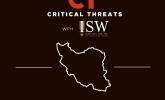Iran Crisis Update, October 14
October 14, 2022 - ISW PressIran Crisis Update, October 14
Nicholas Carl, Kitaneh Fitzpatrick, Zachary Coles, and Frederick W. Kagan
October 14, 5:00 pm ET
Iran Crisis Update, October 14
Nicholas Carl, Kitaneh Fitzpatrick, Zachary Coles, and Frederick W. Kagan
October 14, 5:00 pm ET

Russian President Vladimir Putin likely attempted to make a virtue of necessity by announcing that his “partial” mobilization will end in “about two weeks”—the same time the postponed fall conscription cycle is set to begin. Putin told reporters on October 14 that “nothing additional is planned” and that "partial mobilization is almost over." As ISW previously reported, Putin announced the postponement of Russia’s usual autumn conscription cycle from October 1 to November 1 on September 30, likely because Russia’s partial mobilization is taxing the bureaucracy of the Russian military commissariats that oversee the semiannual conscription cycle. Putin therefore likely needs to pause or end his partial mobilization to free up bureaucratic resources for conscription. Putin ordered the conscription of 120,000 men for the autumn cycle, 7,000 fewer than in autumn 2021. However, Russia’s annexation of occupied Ukraine changes the calculus for conscripts. Russian law generally prohibits the deployment of conscripts abroad. Russian law now considers Russian-occupied Kherson, Zaporizhia, Donetsk, and Luhansk oblasts to be Russian territory, however, ostensibly legalizing the use of conscripts on the front lines.

Expanding protests could strain Iranian state security services beyond their capabilities to respond in the coming days. Anti-regime protest organizations and social media accounts have called for protests in Khuzestan Province on October 14 and throughout the country on October 15. A group called the Youth of the Whole Country, which began tweeting on October 11, has repeated these calls and stated that it seeks to overthrow the regime. The group added that it has coordinated with local protest leaders throughout Iran. Numerous other Persian-language social media accounts with similar naming conventions are circulating on Twitter, claiming to represent Iranian protesters in cities across the country. The Youth of Tehran Neighborhoods tweeted that the October 15 demonstrations will be “the beginning of the end [for the regime].”

Public reports of the first deaths of ill-prepared mobilized Russian troops in Ukraine have sparked renewed criticism of the Russian military command. Russian media reported that five mobilized men from Chelyabinsk have already died in combat in Ukraine just three weeks after President Vladimir Putin’s declaration of partial mobilization on September 21. The report led many pro-war milbloggers to claim that the number of dead and wounded among mobilized servicemen is likely higher than this due to lack of promised training, equipment, unit cohesion, and commanders, as well as repeated instances of wrongful mobilization.
Iranian leadership is still largely speaking to itself rather than to the Iranian people. Iranian officials continue to ignore protester grievances and are instead emphasizing their readiness to brutally crack down. Supreme Leader Ali Khamenei addressed the protests publicly for the second time on October 12, reiterating his accusation that foreign enemies are responsible for the unrest. He dismissed the protests as minor events. Khamenei did not mention Mahsa Amini or the citizens killed in the protests. Khamenei likely sought to reaffirm to the political and security establishment his approval of the brutal crackdown while portraying strength.

Russia has seemingly intensified its information operation to falsely portray Ukraine as a terrorist state, likely to set information conditions to counter efforts to designate Russia as a terrorist state. Several Russian sources made unverified claims that Russian Federal Security Service (FSB) officers detained Ukrainian citizens for allegedly planning “terrorist attacks” in Sverdlovsk, Moscow, and Bryansk oblasts on October 12. Russian milbloggers relatedly amplified rhetoric accusing Ukraine of being a terrorist state and calling for Russian authorities to enhance “counterintelligence” procedures and formally designate Ukraine as a terrorist state. Claims of preparations for alleged and subversive Ukrainian activity in Russia align with a wider attempt to set information conditions to respond to Ukrainian attempts to formally designate Russia a terrorist state, especially in the wake of recent massive attacks on critical Ukrainian infrastructure and residential areas. The Russian information space may also be setting conditions to justify further massive strikes on Ukrainian rear areas; although, as ISW has previously assessed, these tactics are part of the Russian way of war and will likely be utilized regardless of informational conditions. Russian authorities may also be setting conditions for false-flag attacks against Russia framed as Ukrainian-perpetrated acts of terrorism.

Russian forces conducted massive missile strikes across Ukraine for the second day in a row on October 11. The Ukrainian General Staff stated that Russian forces fired nearly 30 Kh-101 and Kh-55 cruise missiles from Tu-95 and Tu-160 strategic bombers and damaged critical infrastructure in Lviv, Vinnytsia, Dnipropetrovsk, Donetsk, and Zaporizhia oblasts. Ukrainian air defense reportedly destroyed 21 cruise missiles and 11 unmanned aerial vehicles (UAVs). Social media footage shows the aftermath of strikes throughout Ukraine. Russian forces additionally continued to launch attacks on Ukrainian infrastructure with Iranian-made Shahed-136 drones. The Ukrainian General Staff reported that Ukrainian air defense destroyed eight Shahed-136 drones in Mykolaiv Oblast on the night of October 10 and 11.
Unconfirmed reports suggest that the Iranian regime is amassing military and security forces in Kurdistan Province to violently suppress protests and possibly also to conduct a ground operation into Iraqi Kurdistan.[1] Social media rumors reported on October 10 that the Islamic Revolutionary Guards Corps (IRGC) and Law Enforcement Command (LEC) have transferred forces from Hamedan, Yazd, and elsewhere to Sanandaj, where the regime is conducting a brutal crackdown.[2] Anti-regime outlet IranWire and a UK-based Sky News journalist reported that the regime is concentrating forces in Kurdistan Province.[3]

Russian forces conducted a massive missile strike attack against over 20 cities, including Kyiv, on October 10. The Ukrainian General Staff reported that Russian forces launched over 84 cruise missiles and 24 drone attacks, 13 of which were carried out with Iranian-made Shahed-136 drones. Ukrainian air defense shot down 43 cruise missiles, 10 Shahed-136 drones, and 3 unspecified drones. Russian forces launched missiles from 10 strategic bombers operating in the Caspian Sea and from Nizhny Novgorod, Iskander short-range ballistic missile systems, and 6 missile carriers in the Black Sea. Russian forces launched the Shahed-136 drones from Crimea and Belarus. Ukrainian media reported that Russian missile strikes hit 70 targets, including 29 critical infrastructure facilities, 4 high-rise buildings, 35 residential buildings, and a school.

The ongoing, anti-regime protests could interact with and feed off of preexisting insurgencies in Iran. There are at least three active but low-level insurgencies in Iran’s northwestern, southwestern, and southeastern border regions. Iranian Arab, Baloch, and Kurdish militant groups have leveraged economic and political frustrations among marginalized minorities in Iran to fuel these groups’ anti-regime agendas for decades. These groups, which include the Kurdistan Free Life Party and Jaish al Adl, have historically conducted attacks into Iran and clashed with state security services regularly.